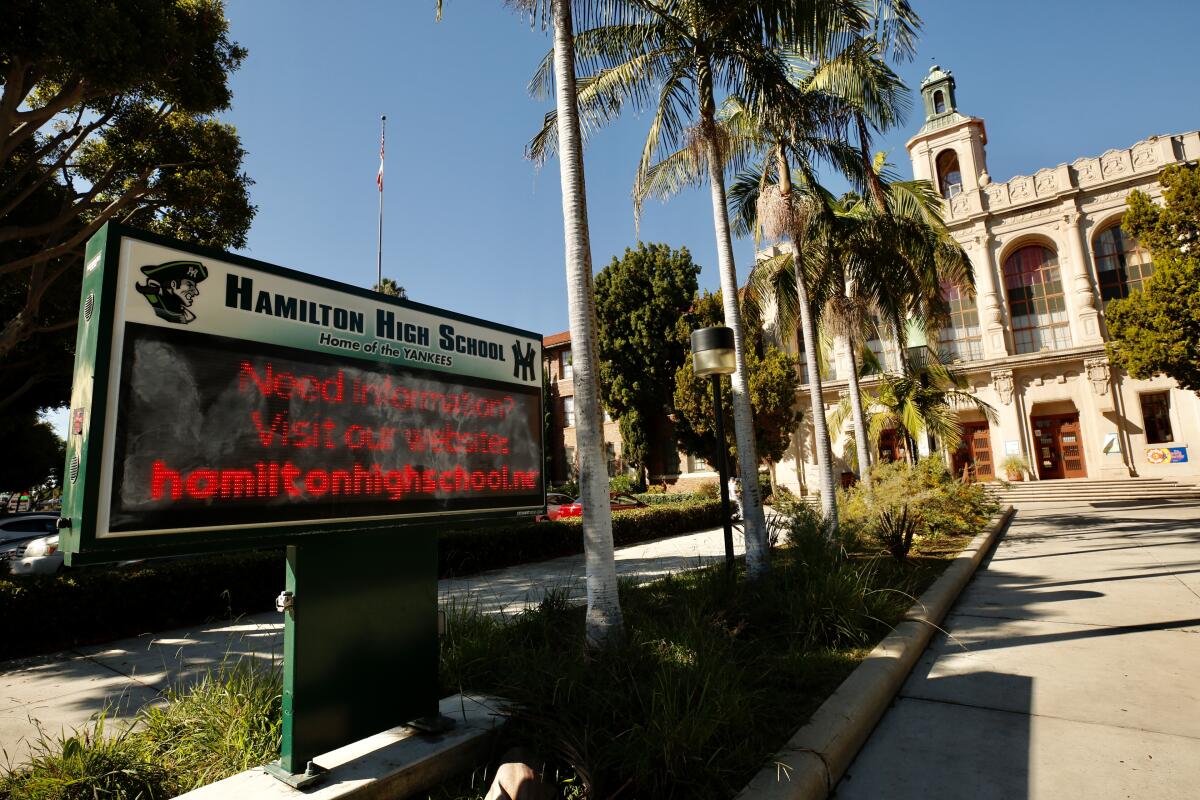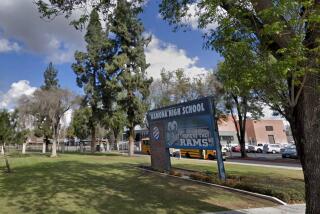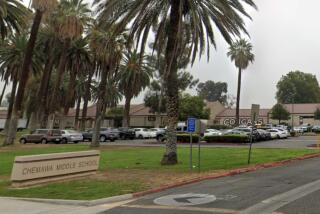Educators report a rise in school threats, fights and misbehavior, and blame COVID

A 14-year-old in the Central Valley was arrested Monday after he allegedly threatened to kill two classmates. On Sunday night, police arrested a Buena Park High School student after he allegedly shared a photo of a person holding a gun and captioned it with a warning to classmates to stay away from school âif you wanna live.â
And after a social media threat was investigated at Santa Monica High School and campus was deemed safe, Supt. Ben Drati sent a message to the school community clarifying a recent spate of high school threats to his worried community: âThere were other threats in the area that were confused with the (Santa Monica High School) threat that was determined to be an isolated incident, not related to any other threats you may have heard about at Palisades, Hamilton or Fairfax High School.â
Months after students returned to campuses â and a week after four were killed in a shooting at a Michigan high school â multiple schools in Southern California and elsewhere have reported receiving threats of violence, compounding campus tensions at a time when school administrators and teachers say students are increasingly acting out in class, showing aggressive behavior and fighting.
After the Nov. 30 Michigan shooting in which a 15-year-old student has been charged with murder, more than a dozen school districts in the state canceled classes, citing potential threats posted online. Many times after school shootings, copycat behavior can follow for weeks, if not months, said Tyrone Howard, education professor at UCLA.
In Buena Park, police began receiving calls and emails Sunday night about a student who posted a threat online, said Sgt. Chad Weaver, the department public information officer. The student was arrested within hours of initial calls and transferred to juvenile detention.
While there is no current data that aggregates reports among educators and law enforcement about reported upticks in threats, school fights, assaults or behavior troubles, Howard and other educators said students are experiencing anxiety, suicidal ideation and depression, all signs that they are struggling.
âYoung people donât know how to cope when theyâre depressed and angry,â Howard said. He added that children experiencing trauma often respond in one of three ways: they become aggressive, reclusive or tune the world out.
Communities In Schools of Los Angeles, a nonprofit that collaborates with several Los Angeles Unified School District schools to provide academic support, said staff at school sites have seen an increase in aggression and misbehavior among students. Students from second to fourth grade displaying behavior similar to kindergartners and younger students are having trouble acclimating to rules and cultural norms, likely due to the amount of time they were out of in-person school, said Elmer Roldan, executive director of the organization.
âOur staff has seen an increase in fights between students and [are] concerned by incidents of sexual harassment between students, often stemming from social media challenges,â Roldan said.
U.S. Surgeon General Vivek H. Murthy issued a rare public health advisory this week about the crisis facing youth mental health. While children and adolescents have increasingly reported feeling distressed over the past years, the hardships brought on by the pandemic have compounded the pain, Murthy concluded.
âAll those signs are telling us that children are not well and are dealing with the effects of the pandemic,â Howard said. âJust the disconnect from friends and social connections, even though theyâre now reconnecting, just that absence can have a massive effect.â
While people tend to address mental health, violent behavior and stressors like food and housing insecurity in isolation, itâs important to consider how the issues compound, said Ron Avi Astor, a professor of education and social welfare at UCLA.
In Los Angeles, one high school teacher said there has been an âoutsized increase in the number of fights, graffiti and vandalismâ as well as mental health crises on campus this year. The teacher, who asked to not be named, linked the behavior to social media. Anonymous Instagram accounts have appeared that have hurt studentsâ mental health, including ones dedicated to taking photos of studentsâ backsides and another dedicated to photos of studentsâ shoes under bathroom stalls.
âStudents are instigating conflict online and when they have to see each other face-to-face they donât know how to resolve their issues,â the teacher said. Staff at the school have tried to get Instagram to remove the accounts, but to no avail, he said.
Astor pointed out that this behavior in schools existed long before social media, but it has further fragmented relationships for children who spend several hours each day online in the âabsence of time spent with other real human beings.â
âTheyâre not doing sports, theyâre not doing youth group, theyâre not meeting neighborhood kids. What that means is theyâre isolated,â he said.
Still, both Howard and Astor noted that schools can play a pivotal role in providing âradical care,â which is the idea that schools can provide what students need outside of academic learning, such as food, shelter and mental health support.
âHistorically, schools have also played the role of creating a better society and a better world,â Astor said. âThis is the right time to retreat back to that.â
More to Read
Sign up for Essential California
The most important California stories and recommendations in your inbox every morning.
You may occasionally receive promotional content from the Los Angeles Times.











